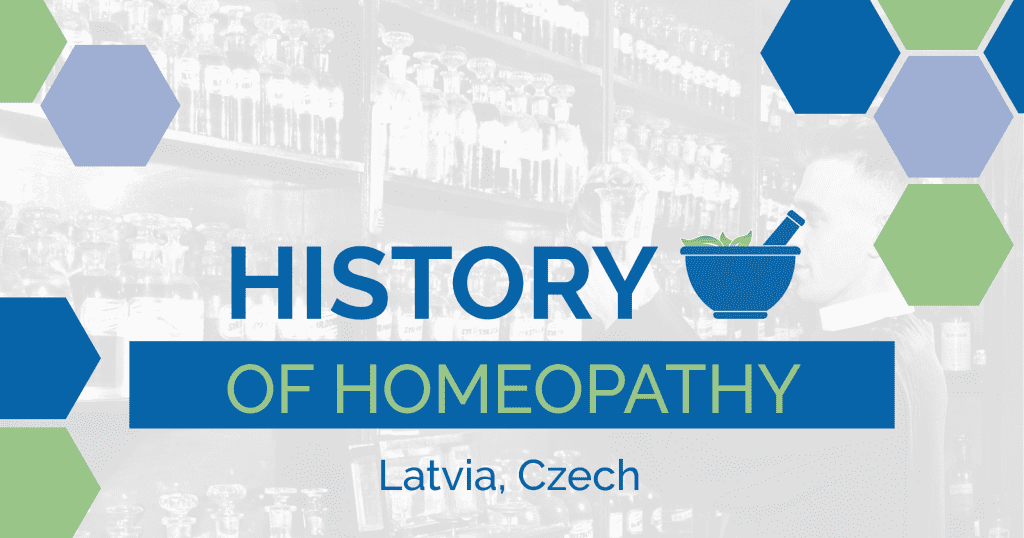Snapshots From the There and Then

In honor of AAHP’s 100th Anniversary (1923–2023) year, we look back at the history of homeopathy to find out how this medical modality spread around the world. One also discovers startling vignettes of unexpected paths and outcomes. Readers may know much of homeopathy here and now, but we hope you find our "There and Then" informative and interesting.
Latvia
The language and cultural mores in Latvia shared a commonality with nearby Germany, which allowed homeopathy to prosper early. This was helped by an upper class of bureaucrats, merchants, and others, mostly from Germany. Thus, already in 1833, a homeopathic pharmacy opened in Riga. Over the next century, steady growth in the use of homeopathic medicines allowed other pharmacies to prosper, also. This growth was spurred on by the translation and printing of German homeopathic texts into the vernacular language. Many of these were self-treatment texts for rural patients where there were no medical practitioners.
During the period between the two world wars, Latvia was independent, and homeopathic activities grew, although, for the most part, only in private practices. Some physicians also became interested in medicines made from Himalayan plants and investigated their homeopathic use, eventually bringing them into the product offerings of the Riga homeopathic pharmacy.
After WWII, Latvia fell under Soviet authority. In other countries, this change resulted in the demise of homeopathy. But that first Riga homeopathic pharmacy continued to make and sell homeopathic medicines, even after being nationalized. In 1959 private medical practices, including homeopathic ones, were outlawed, and homeopathy was excluded from the list of doctor's specialties. Due to the Riga pharmacist’s personal connections, a homeopathic department in a clinic was opened, though it lasted only a few months. However, many patients wrote numerous complaints to the Ministry, and the clinic was reopened soon after; by 1970, there were 18 homeopathic physicians on staff.
Wilmar Schwabe’s manual* on the preparation of homeopathic products remained a lodestone of information in the Riga pharmacy, and almost all medicines are still prepared in the Riga pharmacy. The pharmacy bought and processed up to 11,000 pounds of plant material each year; homeopathic pharmacists from Latvia and neighboring countries came to be trained in how to make homeopathic drug products. For years, the pharmacy supplied all three Baltic republics and Belorussia with homeopathic medicines.
Today, homeopathy is accepted as a supplementary medical doctor's specialty in both private practices and medical centers. Doctors have the possibility of training abroad. Some seminars of the Kyiv (Ukraine) homeopathic school take place in Riga, and there also is a three-year course at one of the universities. The public’s attitude towards homeopathy continues to become more and more positive due to its indisputable efficiency. The number of patients wishing to receive homeopathic treatment continues to grow rapidly.
The original Riga homeopathic pharmacy continues operation — 190 years after its founding! It no longer exports, instead providing homeopathic medicines only within Latvia by supplying the ordinary town and rural pharmacies as needed for the prescriptions of homeopathic doctors who are now spread throughout the country.
Czech
Although there was a small homeopathic presence, including a small hospital in the Czech territory in the 1860s, the historical record indicates the early practitioners seemed to be mostly visiting from adjacent Germany. During the communist era (starting in 1948), suppression of homeopathy was far stronger and more effective in Czechoslovakia than in other eastern bloc countries. After the Velvet Revolution in 1989, homeopathy burst forth as if making up for lost time.
Numerous physician courses have been held in the past three decades, with practitioners returning multiple times for renewal and deepening their homeopathic knowledge. Instructors include many of the most famous teachers of homeopathy from around the world. Instruction was also augmented by local Czech presenters. In a country of 10 million inhabitants, more than a half dozen associations have been established with non-competing goals. They host seminars, weekend workshops, and even artistic events to honor and celebrate homeopathic medicines.
Homeopathic medicines and practice are both legal. The national insurance does not separately cover homeopathic medicines, so almost all the 1,000 homeopathic practitioners do so as part of their broader medical practice. Homeopathic drug products can easily be found in most pharmacies throughout the country.
*Schwabe’s Manual was the basis of the 1934 edition of the German Homeopathic Pharmacopeia. It strongly influenced Boericke & Tafel’s American Homeopathic Pharmacopeia and sections of the early editions of the Homeopathic Pharmacopeia of the United States published by the American Institute of Homeopathy.
References:
https://pihma-fpre.org/wp-content/uploads/2015/07/History-of-Homeopathy-in-Latvia.pdf
